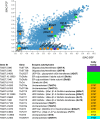Common and unique features of glycosylation and glycosyltransferases in African trypanosomes
- PMID: 36066312
- PMCID: PMC9472816
- DOI: 10.1042/BCJ20210778
Common and unique features of glycosylation and glycosyltransferases in African trypanosomes
Abstract
Eukaryotic protein glycosylation is mediated by glycosyl- and oligosaccharyl-transferases. Here, we describe how African trypanosomes exhibit both evolutionary conservation and significant divergence compared with other eukaryotes in how they synthesise their glycoproteins. The kinetoplastid parasites have conserved components of the dolichol-cycle and oligosaccharyltransferases (OSTs) of protein N-glycosylation, and of glycosylphosphatidylinositol (GPI) anchor biosynthesis and transfer to protein. However, some components are missing, and they process and decorate their N-glycans and GPI anchors in unique ways. To do so, they appear to have evolved a distinct and functionally flexible glycosyltransferases (GT) family, the GT67 family, from an ancestral eukaryotic β3GT gene. The expansion and/or loss of GT67 genes appears to be dependent on parasite biology. Some appear to correlate with the obligate passage of parasites through an insect vector, suggesting they were acquired through GT67 gene expansion to assist insect vector (tsetse fly) colonisation. Others appear to have been lost in species that subsequently adopted contaminative transmission. We also highlight the recent discovery of a novel and essential GT11 family of kinetoplastid parasite fucosyltransferases that are uniquely localised to the mitochondria of Trypanosoma brucei and Leishmania major. The origins of these kinetoplastid FUT1 genes, and additional putative mitochondrial GT genes, are discussed.
Keywords: evolutionary biology; glycosylation; glycosyltransferases; trypanosomes.
© 2022 The Author(s).
Conflict of interest statement
The authors declare that there are no competing interests associated with the manuscript.
Figures



Similar articles
-
A Trypanosoma brucei β3 glycosyltransferase superfamily gene encodes a β1-6 GlcNAc-transferase mediating N-glycan and GPI anchor modification.J Biol Chem. 2021 Oct;297(4):101153. doi: 10.1016/j.jbc.2021.101153. Epub 2021 Sep 1. J Biol Chem. 2021. PMID: 34478712 Free PMC article.
-
Steric constraints control processing of glycosylphosphatidylinositol anchors in Trypanosoma brucei.J Biol Chem. 2020 Feb 21;295(8):2227-2238. doi: 10.1074/jbc.RA119.010847. Epub 2020 Jan 13. J Biol Chem. 2020. PMID: 31932305 Free PMC article.
-
Transcript expression analysis of putative Trypanosoma brucei GPI-anchored surface proteins during development in the tsetse and mammalian hosts.PLoS Negl Trop Dis. 2012;6(6):e1708. doi: 10.1371/journal.pntd.0001708. Epub 2012 Jun 19. PLoS Negl Trop Dis. 2012. PMID: 22724039 Free PMC article.
-
The GPI biosynthetic pathway as a therapeutic target for African sleeping sickness.Biochim Biophys Acta. 1999 Oct 8;1455(2-3):327-40. doi: 10.1016/s0925-4439(99)00058-7. Biochim Biophys Acta. 1999. PMID: 10571022 Review.
-
The glycosylation of the variant surface glycoproteins and procyclic acidic repetitive proteins of Trypanosoma brucei.Mol Biochem Parasitol. 1998 Mar 1;91(1):145-52. doi: 10.1016/s0166-6851(97)00187-4. Mol Biochem Parasitol. 1998. PMID: 9574932 Review.
Cited by
-
Identification of the glycosylphosphatidylinositol-specific phospholipase A2 (GPI-PLA2) that mediates GPI fatty acid remodeling in Trypanosoma brucei.J Biol Chem. 2023 Aug;299(8):105016. doi: 10.1016/j.jbc.2023.105016. Epub 2023 Jul 5. J Biol Chem. 2023. PMID: 37414151 Free PMC article.
-
Generation of a bloodstream form Trypanosoma brucei double glycosyltransferase null mutant competent in receptor-mediated endocytosis of transferrin.PLoS Pathog. 2024 Jun 27;20(6):e1012333. doi: 10.1371/journal.ppat.1012333. eCollection 2024 Jun. PLoS Pathog. 2024. PMID: 38935804 Free PMC article.
References
-
- Stanley, P., Moremen, K.W., Lewis, N.E., Taniguchi, N. and Aebi, M. (2022) N-Glycans. In Essentials of Glycobiology (Varki, A., Cummings, R.D., Esko, J.D., Stanley, P., Hart, G.W., Aebi, M. et al. eds), pp. 103–116, Cold Spring Harbor, NY
-
- Komath, S.S., Fujita, M., Hart, G.W., Ferguson, M.A.J. and Kinoshita, T. (2022) Glycosylphosphatidylinositol anchors. In Essentials of Glycobiology (Varki, A., Cummings, R.D., Esko, J.D., Stanley, P., Hart, G.W., Aebi, M. et al. eds), pp. 141–154, Cold Spring Harbor, NY
Publication types
MeSH terms
Substances
Grants and funding
LinkOut - more resources
Full Text Sources
Miscellaneous

